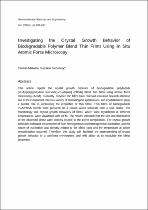 ResearchSpace
ResearchSpace
Investigating the crystal growth behavior of biodegradable polymer blend thin films using in situ atomic force microscopy
JavaScript is disabled for your browser. Some features of this site may not work without it.
- ResearchSpace
- →
- Research Publications/Outputs
- →
- Journal Articles
- →
- View Item
| dc.contributor.author |
Malwela, T

|
|
| dc.contributor.author |
Ray, Suprakas S

|
|
| dc.date.accessioned | 2014-09-12T10:00:40Z | |
| dc.date.available | 2014-09-12T10:00:40Z | |
| dc.date.issued | 2014 | |
| dc.identifier.citation | Malwela, T and Ray, S.S. 2014. Investigating the crystal growth behavior of biodegradable polymer blend thin films using in situ atomic force microscopy. Macromolecular Materials and Engineering, vol. 299(6), pp 689-697 | en_US |
| dc.identifier.issn | 1438-7492 | |
| dc.identifier.uri | http://onlinelibrary.wiley.com/doi/10.1002/mame.201300281/pdf | |
| dc.identifier.uri | http://hdl.handle.net/10204/7667 | |
| dc.description | Copyright: 2014 Wiley. This is an ABSTRACT ONLY. The definitive version is published in Macromolecular Materials and Engineering, vol. 299(6), pp 689-697 | en_US |
| dc.description.abstract | This article reports the crystal growth behavior of biodegradable polylactide (PLA)/poly[(butylene succinate)-co-adipate] (PBSA) blend thin films using atomic force microscopy (AFM). Currently, polymer thin films have received increased research attention due to their important role in a variety of technological applications, and crystallization plays a pivotal role in controlling the properties of thin films. Thin films of biodegradable PLA/PBSA blends were prepared on a silicon wafer substrate with a spin coater. The morphology and crystal growth behaviors of films, which were crystallized at different temperatures, were visualized with AFM. The results indicated that the size and distribution of the dispersed phase were directly related to the blend composition. The crystal growth behaviors indicated the presence of both homogeneous and heterogeneous nucleation, and the nature of nucleation was directly related to the blend ratio and the temperature at which crystallization occurred. Therefore, this study will facilitate the understanding of crystal growth behavior in a confined environment and will allow us to modulate the blend properties. | en_US |
| dc.language.iso | en | en_US |
| dc.publisher | Wiley | en_US |
| dc.relation.ispartofseries | Workflow;13388 | |
| dc.subject | Biodegradable polylactide | en_US |
| dc.subject | Atomic force microscopy | en_US |
| dc.subject | AFM | en_US |
| dc.subject | Polymer thin films | en_US |
| dc.title | Investigating the crystal growth behavior of biodegradable polymer blend thin films using in situ atomic force microscopy | en_US |
| dc.type | Article | en_US |
| dc.identifier.apacitation | Malwela, T., & Ray, S. S. (2014). Investigating the crystal growth behavior of biodegradable polymer blend thin films using in situ atomic force microscopy. http://hdl.handle.net/10204/7667 | en_ZA |
| dc.identifier.chicagocitation | Malwela, T, and Suprakas S Ray "Investigating the crystal growth behavior of biodegradable polymer blend thin films using in situ atomic force microscopy." (2014) http://hdl.handle.net/10204/7667 | en_ZA |
| dc.identifier.vancouvercitation | Malwela T, Ray SS. Investigating the crystal growth behavior of biodegradable polymer blend thin films using in situ atomic force microscopy. 2014; http://hdl.handle.net/10204/7667. | en_ZA |
| dc.identifier.ris | TY - Article AU - Malwela, T AU - Ray, Suprakas S AB - This article reports the crystal growth behavior of biodegradable polylactide (PLA)/poly[(butylene succinate)-co-adipate] (PBSA) blend thin films using atomic force microscopy (AFM). Currently, polymer thin films have received increased research attention due to their important role in a variety of technological applications, and crystallization plays a pivotal role in controlling the properties of thin films. Thin films of biodegradable PLA/PBSA blends were prepared on a silicon wafer substrate with a spin coater. The morphology and crystal growth behaviors of films, which were crystallized at different temperatures, were visualized with AFM. The results indicated that the size and distribution of the dispersed phase were directly related to the blend composition. The crystal growth behaviors indicated the presence of both homogeneous and heterogeneous nucleation, and the nature of nucleation was directly related to the blend ratio and the temperature at which crystallization occurred. Therefore, this study will facilitate the understanding of crystal growth behavior in a confined environment and will allow us to modulate the blend properties. DA - 2014 DB - ResearchSpace DP - CSIR KW - Biodegradable polylactide KW - Atomic force microscopy KW - AFM KW - Polymer thin films LK - https://researchspace.csir.co.za PY - 2014 SM - 1438-7492 T1 - Investigating the crystal growth behavior of biodegradable polymer blend thin films using in situ atomic force microscopy TI - Investigating the crystal growth behavior of biodegradable polymer blend thin films using in situ atomic force microscopy UR - http://hdl.handle.net/10204/7667 ER - | en_ZA |





